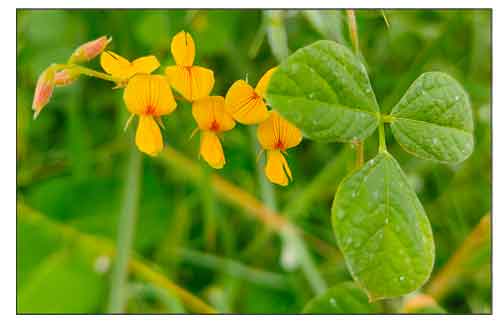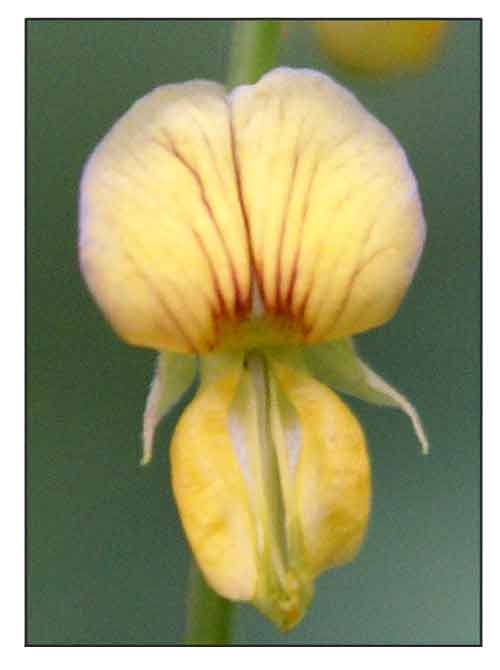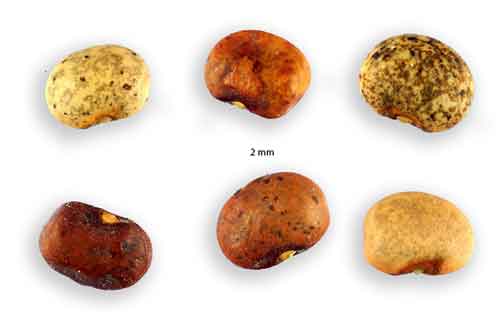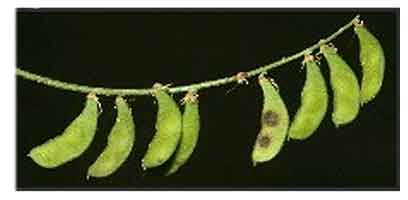Gen info
- Rhynchosia minima is a species of flowering plant in the legume family, Fabaceae. It is found in every continent.
- The genus Rhynchosia consists
of about 230 species, widely distributed in the tropical and subtropical regions of the world.
 Botany Botany
• A perennial herb with twining or trailing stems which can reach 1.2 meters in length. Leaves are made up of three leaflets measuring up to 3- to 3.5 centimeters long. Inflorescence is a raceme of up to 15 flowers. Flowers are yellow with purple or brown veining and measure up to 8 millimeters long. Fruit is one or two centimeters long. (2)
• Herbs, annual. Stems twining, slender, sparsely pubescent. Leaves pinnately 3-foliolate; stipules small, lanceolate, usually 1-2 mm; petiole 1-4 cm, glabrous or sparsely pubescent; stipels extremely small; petiolules extremely short; leaflets ± membranous; terminal leaflet rhomboid-circular, 1.5-3 × 1.5-3 cm, sometimes wider than long, glabrous or sparsely villous, abaxially densely glandular, basal veins 3, apex obtuse or rounded, rarely shortly acute; lateral leaflets subequal to terminal leaflet or shorter, obliquely circular. Raceme 5-11 cm, axis slender, sparsely pubescent; bracts small, lanceolate, deciduous. Flowers 6-8 mm, slightly curved; pedicel extremely short. Calyx ca. 5 mm, sparsely pubescent; lobes lanceolate, slightly shorter than tube, lower one longer. Corolla yellow, longer than calyx, petals subequal; standard obovate-circular, base with 2 acute auricles; wings obovate-elliptic, auriculate; keels slightly curved, apex obtuse. Legume oblanceolate to ellipsoid, 1-2 × 0.4-0.5 cm, pubescent, 1- or 2-seeded. (Flora of China)
 Distribution Distribution
- Native to the Philippines.
- In grassland regions with pronounced dry season; low elevation.
- Also native to Afghanistan, Algeria, Angola, Argentina Northeast, Argentina Northwest, Aruba, Assam, Bahamas, Bangladesh, Belize, Benin, Bolivia, Botswana, Brazil North, Brazil Northeast, Brazil South, Brazil Southeast, Brazil West-Central, Burkina, Burundi, Cameroon, Cape Provinces, Cape Verde, Cayman Is., Central African Republic, Chad, Chile North, China South-Central, Colombia, Costa Rica, Cuba, Dominican Republic, East Himalaya, Ecuador, Egypt, El Salvador, Eritrea, Ethiopia, Florida, Free State, French Guiana, Galápagos, Georgia, Ghana, Guatemala, Gulf of Guinea Is., Gulf States, Guyana, Haiti, Honduras, India, Ivory Coast, Jamaica, Jawa, Kazan-retto, Kenya, KwaZulu-Natal, Leeward Is., Lesser Sunda Is., Liberia, Louisiana, Madagascar, Malawi, Mali, Mauritania, Mexican Pacific Is., Mexico Central, Mexico Gulf, Mexico Northeast, Mexico Northwest, Mexico Southeast, Mexico Southwest, Morocco, Mozambique, Myanmar, Namibia, Nansei-shoto, Nepal, Netherlands Antilles, New Guinea, New South Wales, Nicaragua, Niger, Nigeria, Northern Provinces, Northern Territory, Oman, Pakistan, Palestine, Panamá, Paraguay, Peru, Puerto Rico, Queensland, Rodrigues, Rwanda, Saudi Arabia, Senegal, Sierra Leone, Sinai, Socotra, Somalia, South Australia, South China Sea, Southwest Caribbean, Sri Lanka, Sudan, Suriname, Swaziland, Taiwan, Tanzania, Texas, Thailand, Togo, Trinidad-Tobago, Turks-Caicos Is., Uganda, Venezuela, Venezuelan Antilles, Vietnam, West Himalaya, Western Australia, Windward Is., Yemen, Zambia, Zaïre, Zimbabwe. (1)
 Constituents Constituents
- Phytochemical screening of ethanol and aqueous extracts of leaves yielded alkaloids, flavonoids, tannins, terpenoids, and glycosides, with absence of steroids. (see study below) (5)
- GC-MS analysis of methanolic extract of leaves revealed presence of 19 compounds. Prevailing compounds were 1-Pentadecene (14.31), alpha. Bisabolol (10.39%), 1-Heptadecene (9.78%),Cyclohexene,4 (1,5dimethyl1,4hexadienyl (7.06%), 3-Hexadecene (Z) (8.10%), Caryophyllene (6.58%), Neophytadiene (5.16%), Humulene (1.91%), Naphthalene,1,2,3,5,6,8 a-hexahydro-4,7-dimethyl (3.72%), Hexadecanoic acid, methyl ester (2.09%), Pentadecanone (3.13%), 8-Octadecanone (4.02%),1-Nonadecene (4.16%), Spiro[4.5]dec-6-en-8-one,1,7-dimethyl-4-(1-methylethyl (2.97%), Neophytadiene (2.24%),(E)-beta-Farnesene (1.92%), Cyclohexene,4-[(1E)-1,5-dimethyl-1,4-hexadien (1.80%), Cyclohexane,octyl (1.45%), beta Bisabolene (9.21%). FTIR leaf analysis showed lipd, protein, phosphate ion, carboxylic acid, hydroxy compound, alipathic bromo compounds. (see study below) (6)
- 1D and 2D NMR and HR-ESI-MS studies of leaf extracts isolated six flavonoids, one norisoprenoid, and one cyclitol: ayanin (1), tectorigenin (2), loliolide (3), isovitexin (4), pinitol (5), vitexin (6), quercetin (7) and isoorientin (8) isolated from R. minima.
(see study below) (8)
- Study of Rhynchosia minima for essential oil showed a yield of 0.21%, with main components of isopropyl toluene, camphene, and O-cymene. (see study below) (9)
- Study of dried powder n-hexane extra of R. minima isolated two compounds, distinguished as lupeol and stigmasterol. (15)
- Study of R. minima for nutrient potential showed leaves with the highest crude protein content (16.24%), nitrogen free extract (51.47%) and IVDMD (64.90%). Whole plant recorded highest total ash content (8.24) and all of studied macro-minerals. Vines showed highest crude fiber content (27.97%) and pods had highest value of ether extract (2.34) and tannins (3.90%).
(see study below) (18)
Properties
- Studies have suggested antioxidant, antinociceptive, anti-inflammatory, anthelmintic, antibacterial, antifungal, antidiabetic, α-glucosidase inhibitory, anticancer, immunomodulatory properties.
Parts used
- Aerial parts, leaves, roots.
 Uses Uses
Edibility
- Plant used for making sweetmeats. (3)
Folkloric
- Roots used as laxative, vermifuge, and for treatment of diarrhea and dysentery. Leaf sap and root used for treatment of hemorrhoids. Leaves used as abortifacient, for inducing uterine contractions. (3)
- Leaf decoction used by tribals of North Maharashtra region as abortifacient. Tribals of Sikkim use leaves for the treatment of wounds, helmintic infections and as abortifacient. In Saurashtra region of Gujarat, aborigines use leaves for treatment of asthma and piles.
- South Africa
traditional healers use the plant for treatment of heart and chest pains. (8)
- In folk herbal medicine in southern China, roots used to relieve itching and swelling. (11)
- In traditional Chinese medicine, roots used for treatment of boils, upper respiratory tract infections, and joint pains. (16)
- In north Maharashtra, India,
leaves used as abortifacient: 20 cc of decoction is given twice daily for 7 days.
Others
• Fodder: Plant used as animal forage.
• Repellent: Seeds used as repellent.
• Poison: Used as fish poison.
• Herbicide: Essential oil from aerial parts studied for potential as pre-emergence herbicide. (3)
• Agroforestry: Potential use as ground cover or in local soil conservation projects. (3)
Studies
• Antioxidant / Antinociceptive / Anti-Inflammatory / Aerial Parts: Study evaluated shade dried, pulverized ethanol and aqueous extracts of aerial parts of R. minima. The extracts exhibited scavenging of free radicals in ABTS and DPPH radical scavenging assay methods, comparable with ascorbic acid and rutin. At doses of 200 and 400 mg/kg p.o., the extracts showed significant inhibition of abdominal writhing by acetic acid by inhibition of peripheral pain receptor in peritoneal cavity lining, and increased pain threshold towards thermal source in a dose dependent manner, possibly by involvement of opioid receptor. Diclofenac and codeine were used as standard references. In carrageenan induced paw acute rat paw edema, the extracts showed significant (p<0.001) decrease in paw edema volume in a dose dependent manner, possibly via inhibition of release and/or action of histamine, serotonin, kinin, and prostaglandin like substances. (4)
• Anthelmintic / Leaves: Study evaluated leaves of R. minima for anthelmintic activity against adult Indian earthworm Pheretima posthuma and Ascardia galli. Results showed petroleum ether, chloroform, ethanol and aqueous extracts exhibited varying degrees of activity against both worms and caused paralysis followed by death at all tested concentrations. Aqueous and ethanolic extracts exhibited more potent activity at higher concentrations (100 mg/ml) compared to reference standard piperazine citrate (10 mg/ml. (5)
• Chemical Component of Leaves and Known Biologic Activities: GC-MS analysis of methanolic extract of leaves revealed presence of 19 compounds. The compounds are known to have antibacterial, antifungal, antioxidant, hemolytic, insecticidal, and lubricant activity. 1-Heptadecene has known antibiotic activity, 8-octadecanone has antimicrobial activity. (see constituents above) (6)
• Antioxidant / Anthelmintic / Whole Plant: Study evaluated the antioxidant and anthelmintic activity of shade dried and powdered aqueous and ethanol extracts of R. minima whole plant. The extracts showed prominent DPPH, hydroxyl radical, Nitric acid, and hydrogen peroxide scavenging activity when compared with standard ascorbic acid. The extracts showed significant anthelmintic activity against adult Indian earthworms Pheretima posthuma at all concentrations when compared with standard albendazole. (7)
• Antifungal / Leaves: Study evaluated extracts and isolated compounds for antifungal activity. Extracts showed moderate to weak antifungal activities against Candida albicans and Cryptococcus neoformans. Two of four isolated compounds showed activity against C. albicans with MIC of 6.25 µg/mL, which was comparable to positive control amphotericin B. Two compounds also showed antifungal potential against C. neoformans with MIC of 6.25 µg/mL, compared to amphotericin B at 12.5 µg/mL. (see constituents above) (8)
• Antimicrobial / Antioxidant / Essential Oil: Study of Rhynchosia minima for essential oil showed a yield of 0.21%, with main components of isopropyl toluene, camphene, and O-cymene. The EO exhibited marked activity against Escherichia coli, Staphylococcus aureus, and Candida albicans. It showed not activity against Clostridium perfringens. The EO also exhibited antioxidant activity. (9)
• α-Glucosidase Inhibitory Activity / Roots: Study evaluated the α-glucosidase inhibitory activity of R. minima root polysaccharide fractions (PRM1, PRM3, and PRM5). PRMC3 showed excellent inhibitory activity with IC50 of 8.85 mg/mL, which is similar to positive control acarbose used for control of postprandial hyperglycemia. Results suggest potential application in functional foods. (10)
• Anticancer / Antioxidant / Root Polysaccharides: Study evaluated the antioxidant abilities and anticancer activity of purified polysaccharide fractions from Rhynchosia minima roots. Main polysaccharide purified fractions were Ara and Gal. PRM3 and PRM5 exhibited remarkable DPPH radical scavenging activities and reducing power in vitro. PRM3 showed strong inhibitory activities on growth of MCF-7 cells in vitro. Results suggest potential for polysaccharides from R. minima roots as natural antioxidants and anticancer food ingredients for the food and pharmaceutical industries. (11)
• Anti-Inflammatory in LPS-Stimulated RAW264.7 Cells / Flavonoids / Roots: Study evaluated the anti-inflammatory activity of ethanol fraction (EEF6) from R. minima root on lipopolysaccharide (LPS)-induced RAW264.7 cells. HPLC-MS of EEF6 isolated five flavonoid compounds viz. 2′,4′,5,7-tetrahydroxy-isoflavone, genistein-8-C-glucopyranoside, tricin, genistein, and daidzein. EEF6 exhibited potent anti-inflammatory ability against LPS-stimulated RAW264.7 cells via MAPK/NF-xB signaling pathways by decreasing the secretion of nitric oxide (NO), interleukin (IL)-6, TNF-α, and monocyte chemotactic protein (MCP)-1, inhibiting the translocation of p65 from cytoplasm to nucleus, and suppressing phosphorylation of ERK, JNK, and p38. Results suggest potential for EEF6 in inflammation management. (12)
• Anticancer / Polysaccharides / Roots: Study purified three novel acidic polysaccharides viz. PRM1, PRM3 and PRM5 from R. minima root using DEAE-52 cellulose and sephadex G-150 column chromatography. Uronic acid contents of PRM1, PRM3 and PRM5 were 30.7%, 12/7%, and 47.7%, respectively. PRM1, PRM3 and PRM5 were heteropolysaccharides composed of arabinose, mannose, glucose, and galactose. PMR3 and PRM1 exhibited strong in vitro anticancer activity against lung cancer A-549 and liver cancer HepG2 cells in a dose-dependent manner. Results suggest PRM1 and PRM3 can be potentially developed as natural anticancer agents. (13)
• Immune Function Enhancement / PMR3 / Roots: Study evaluated the immunoregulatory ability of polysaccharides fractions from R. minima root in vitro and in vivo. PMR3 remarkably enhanced the phagocytic activity of macrophages and promoted the release of NO and secretion of cytokines (TNF-α, IL-6, NS MCP-1) from macrophages, and potently activated NF-kB signaling pathway via TLR4. PMR3 also increased levels of serum cytokines, markedly up-regulated percentages of CD3 and CD4 T lymphocytes and CD4/CD8 ration of splenocytes, and attenuated cyclophosphamide induced immuno-suppression in mice. Results showed PMR3 profoundly enhanced immune function through TLR4-NF-kB pathway, and has potential as immunopotentiator application in functional foods and drugs. (14)
• Nutrient Potential as Livestock Feed: Study evaluated the nutritive status of leaves, vines, pods, and whole plant of R. minima as animal feed, measuring parameters of chemical composition, neutral detergent fiver (NDF), acid detergent fiver (ADF), acid detergent lignin (ADL), macrominerals and tannin contents, an in-vitro dry matter digestibility (IVDMD). Results showed leaves with the highest crude protein content (16.24%), nitrogen free extract (51.47%) and IVDMD (64.90%). Whole plant recorded highest total ash content (8.24) and all of studied macro-minerals. Vines showed highest crude fiber content (27.97%) and pods had highest value of ether extract (2.34) an tannins (3.90%). Results suggest nutrient potential for various parts of R. minima and nutrient potential as livestock feed with superior ranking for leaves and whole plant. (18)
Availability
Wildcrafted. |

 Constituents
Constituents![]()






